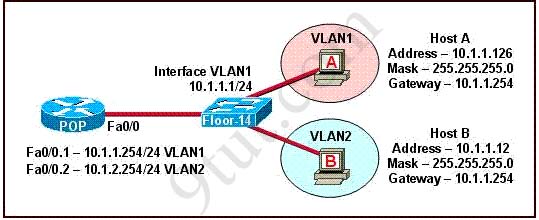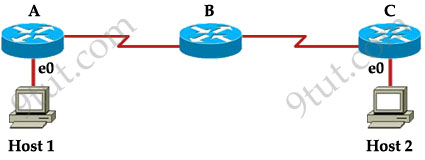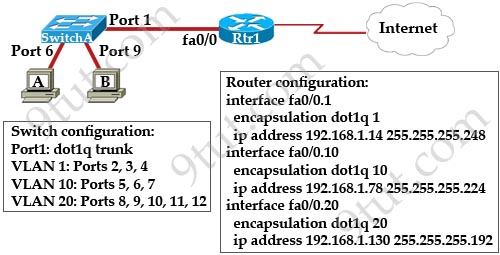New CCNA – Operation Questions
Question 1
Which command would you use on a Cisco router to verify the Layer 3 path to a host?
A. traced address
B. traceroute address
C. telnet address
D. ssh address
Answer: B
Explanation
To check the connectivity between a host and a destination (through some networks) we can use both “tracert” and “ping” commands. But the difference between these 2 commands is the “tracert” command can display a list of near-side router interfaces in the path between the source and the destination. The “traceroute” command has the same function of the “tracert” command but it is used on Cisco routers only, not on a PC -> B is correct.
Question 2
Refer to the exhibit:

Which three statements correctly describe Network Device A? (Choose three)
A. With a network wide mask of 255.255.255.128, each interface does not require an IP address.
B. With a network wide mask of 255.255.255.128, each interface does require an IP address on a unique IP subnet.
C. With a network wide mask of 255.255.255.0, must be a Layer 2 device for the PCs to communicate with each other.
D. With a network wide mask of 255.255.255.0, must be a Layer 3 device for the PCs to communicate with each other.
E. With a network wide mask of 255.255.254.0, each interface does not require an IP address.
Answer: B D E
Explanation
The principle here is if the subnet mask makes two IP addresses 10.1.0.36 and 10.1.1.70 in the same subnet then the Network device A does not need to have IP addresses on its interfaces (and we don’t need a Layer 3 device here).
A quick way to find out the correct answers is notice that all 255.255.255.x subnet masks will separate these two IP addresses into two separate subnets so we need a Layer 3 device here and each interface must require an IP address on a unique IP subnet -> A, C are not correct while B, D are correct.
With 255.255.254.0 subnet mask, the increment here is 2 in the third octet -> the first subnet is from 10.1.0.0 to 10.1.1.255, in which two above IP addresses belong to -> each interface of Network device A does not require an IP address -> E is correct.
Question 3
What are three reasons that an organization with multiple branch offices and roaming users might implement a Cisco VPN solution instead of point-to-point WAN links? (Choose three)
A. reduced cost
B. better throughput
C. broadband incompatibility
D. increased security
E. scalability
F. reduced latency
Answer: A D E
Question 4
What two things will a router do when running a distance vector routing protocol? (Choose two)
A. Send periodic updates regardless of topology changes.
B. Send entire routing table to all routers in the routing domain.
C. Use the shortest-path algorithm to the determine best path.
D. Update the routing table based on updates from their neighbors.
E. Maintain the topology of the entire network in its database.
Answer: A D
Question 5
What is the purpose of the inverse ARP?
A. to map a known DLCI to an IP address
B. to map a known IP address to a MAC address
C. to map known SPID to a MACaddress
D. to map a known DLCI to a MAC address
E. to map a known IP address to a SPID.
F. to map a known MAC address to an IP address
Answer: A
Explanation
For more information about Inverse ARP, please read my Frame Relay tutorial.
Question 6
The network shown in the diagram is experiencing connectivity problems. Which of the following will correct the problems? (Choose two.)

A. Configure the gateway on Host A as 10.1.1.1.
B. Configure the gateway on Host B as 10.1.2.254.
C. Configure the IP address of Host A as 10.1.2.2.
D. Configure the IP address of Host B as 10.1.2.2.
E. Configure the masks on both hosts to be 255.255.255.224.
F. Configure the masks on both hosts to be 255.255.255.240.
Answer: B D
Question 7
Refer to the exhibit. For what two reasons has the router loaded its IOS image from the location that is shown? (Choose two)
|
Router1> show version ROM: System Bootstrap, Version 11.1(11855) [beta 2], INTERIM SOFTWARE Router1 uptime is 23 hours, 33 minutes cisco 7206 (NPE150) processor with 57344K/8192K bytes of memory.
Configuration register is 0×2102 |
A. Router1 has specific boot system command that instruct it to load IOS from TFTP server.
B. Router1 is acting as a TFTP server for other routers.
C. Router1 cannot locate a valid IOS image in flash memory.
D. Router1 defaulted to ROMMON mode and loaded the IOS image from a TFTP server.
E. Cisco routers will first attempt to load a image from TFTP for management purposes.
Answer: A C
Explanation
When powered on, the router first checks its hardware via Power-On Self Test (POST). Then it checks the configuration register to identify where to load the IOS image from. In the output above we learn that the Configuration register value is 0×2102 so the router will try to boot the system image from Flash memory first.
But we also see a line “System image file is “tftp://112.16.1.129/hampton/nitro/c7200-j-mz”. Please notice that this line tells us the image file that the device last started. In this case it is from a TFTP server. Therefore we can deduce that the router could not load the IOS image from the flash and the IOS image has been loaded from TFTP server.
Note:
If the startup-config file is missing or does not specify a location, it will check the following locations for the IOS image:
+ Flash (the default location)
+ TFTP server
+ ROM (used if no other source is found)
Question 8
Host 1 is trying to communicate with Host 2. The e0 interface on Router C is down. Which of the following are true? (Choose two)

A. Router C will use ICMP to inform Host 1 that Host 2 cannot be reached.
B. Router C will use ICMP to inform Router B that Host 2 cannot be reached.
C. Router C will use ICMP to inform Host 1, Router A, and Router B that Host 2 cannot be reached.
D. Router C will send a Destination Unreachable message type.
E. Router C will send a Router Selection message type.
F. Router C will send a Source Quench message type.
Answer: A D
Explanation
The last known good router will try to inform you that the destination cannot be reached (with a Destination Unreachable message type) so from that information you can learn how far your packets can travel to and where the problem is.
Question 9
How is an EUI-64 format interface ID created from a 48-bit MAC address?
A. by appending 0xFF to the MAC address.
B. by prefixing the MAC address with 0xFFEE.
C. by prefixing the MAC address with 0xFF and appending 0xFF to it.
D. by inserting 0xFFFE between the upper three bytes and the lower three bytes of the MAC address
E. by prefixing the MAC address with 0xF and inserting 0xF after each of its first three bytes.
Answer: D
Explanation
We convert a 48-bit MAC address (IEEE 802) to a 64-bit value by breaking the MAC address into its two 24-bit halves. The first part is the Organizationally Unique Identifier (OUI) and the next part is the NIC specific part. Then the 16-bit hex value 0xFFFE is inserted between them to create a 64-bit value.

Just for your information, to obtain an IPv6 interface identifier from EUI-64 address, we have to complement the U/L bit (the seventh bit of the first byte and is used to determine whether the address is universally or locally administered). This means if it is a 1, it is set to 0; and if it is a 0, it is set to 1. In the above example, the U/L bit is 0 (from 00 = 0000 0000). Therefore we have to set this bit to 1 to create an IPv6 interface address.
Question 10
Refer to the exhibit:

A network administrator is adding two new hosts to SwitchA. Which three values could be used for the configuration of these hosts? (Choose three)
A. host A IP address: 192.168.1.79
B. host A IP address: 192.168.1.64
C. host A default gateway: 192.168.1.78
D. host B IP address: 192.168.1.128
E. host B default gateway: 192.168.1.129
F. host B IP address: 192.168.1.190
Answer: A C F



Hello Guys I hope you will be fine there.Now New CCNA (200-120) and CCNA security (640-554) Vouchers on special discount of 58% for World wide, with six months expiry date till you purchase. Each voucher cost 70USD.
Details Required For CCNA Voucher For Discount Processing:
1-Full Name. 1st Name & Last Name (as you want to appear on certificate & documents)
2-Country.
3-City.
4-State.
5-Pin Code (or Area Code)
6-Residential Address (or where you can collect your Certificate or further correspondence
can be received)
7-Date of birth
Add me on Skype through this information which is written below:
Skype Name: rockon660
you can also email me at this email address which is written below:
madeelqaiser@gmail.com
If you have any Questions feel free to contact me.
Thanks,
Best regards,
Adeel
download latest dumps from
9
t
u
t
.
c
o
m
x
a
.
c
o
m
good
I PASSED yesterday, thanks to 9tut…..got a 920……woooohhoooo, study up!!!!
@9tut: Question 2 in the quiz only expect 2 answers, but 3 are correct.
please can anyone help me question 10 why the answers are A, C and F. why is not C, E AND F
Aman,
Answer A is correct because host A is attached to switch port 6, which is in VLAN 10. In the router config, VLAN 10 has been assigned an IP address of 192.168.1.78 with a subnet mask of 255.255.255.224, which means that this subnet starts at 192.168.1.64 and ends at 192.168.1.95, therefore a host can be assigned any address between 192.168.1.65 and 192.168.1.94, answer A is within this range and has not already been assigned to something else.
Answer E is wrong because host B is attached to switchport 9, which is in VLAN 20. The router config shows that VLAN 20 has been assigned an IP address of 192.168.1.130 and therefore that address becomes the default-gateway for all hosts in VLAN 20. Host B should be configured with a default gateway of 192.168.1.130, not 192.168.1.129
download free latest dumps from
9tut.webs,com
(replace comma with dot)
Hi, can anyone ps email me info on how to get the latest VCE 3.4.2 crack version or the version that can open recent dumps.
My email address is: mehdi01912330796@gmail.com
Thanks.
Q1 was in today’s exam.
I cleared 200-120
Question 2 & 6 in today’s exam
Almost all questions from 9tut
Thanks everyone :)
i’m thinking q10 answers are B,C,D
hi. anyone resolved question 10 please? thursday i have my ccna exam.
No B ; D are the network address
Vlan10:
net 192.168.1.64/28
broadcast 192.168.1.95/28
Fa0/1.10 192.168.1.78 255.255.255.224
Vlan 20 :
net 192.168.1.128/26
broadcast 192.168.1.191/26
hostA: A: 192.168.1.79
C: Default gateway 192.168.1.78
hostB: F: IP address 192.168.1.190
download free dumps from
wurl.cc/52R
I don’t understand Q2. Is it E correct? With a network WIDE mask of 255.255.254.0, each interface does require an IP address. plz someone explain…
They’re both in the same subnet with a network WIDE mask of 255.255.254.0. Therefore L2, no gateway required.
The Premium Member question (randomized number) that corresponds to the the New CCNA – Operation Questions #2 needs to be corrected. It appears to only accept 2 answers as correct and is marking the question wrong if you enter the 255.255.254.0 mask as a third solution. Please correct as there is no current way to get this question correct.
can someone please explain why answer “D” is correct on question 6
Fa0/0.2 is at vlan 2 with the IP:10.1.2.254/24
that means that the PC B which is in the same vlan must be in the same network 10.1.2.0/24
thats why we must change the ip from 10.1.1.12(that belong to the network 10.1.1.0/24) to 10.1.2.2
Q1,10 were in the today exam
Question 5 was in the exam recently
I just passed the ccna operation exam and now i start preparing my nest exam ccna data center through ccnapass4sure.com. All above questions are in my exam mostly Q10…
http://www.slideshare.net/cacciblansa/ccna-data-center-dumps
Question 4:
What two things will a router do when running a distance vector routing protocol? (Choose two)
The answer(s) of A & D are given, but, as there are 2 common Distance Vector protocols in CCNA, RIP and EIGRP – EIGRP DOES NOT send periodic updates – this is taken straight from my CCNA handbook, Book3 Chapter 7. Theres trick questions, but hell this is wrong!
” Unlike RIP, EIGRP does not send periodic updates and route entries do not age out.”
Question10:
VLAN10: 192.168.1.78 (010 0 1110)/27 ==> Net: 192.168.1.64/27 ; start: 192.168.1.65 (0100 0001) –> end:192.168.1.95(010 1 1111)
VLAN20: 192.168.1.130(10 00 0010)/26 ==> Net: 192.168.1.128/26; start: 192.168.1.129(10 00 0001)–> end:192.168.1.191(10 11 1111)
can anyone tell me why 9tut is so popular
I have a doubt about q4.
EIGRP dosn’t send periodic updates, so, why answer A is ok?
Thanks for your answers
EIGRP is not a distance vector protocol, is a hybrid protocol. Think about RIP in these questions.
@ithory – EIGRP is an Advanced Distance Vector Protocol
Thanks 9tut.
There is no need to go for any dump or VCE just read and understand all the question of this site one time.
Best of luck
Can anyone send me latest CCNA dumps??
Mail Id: Arya.ckd@gmail.com
question 1 & 10 on exam today
hye friends i have latest dumps exam no 200-120 i download by actual test.com if any one interested its cost 1000 rupee only.my gmail i.d sabeehhaider14@gmail.com
q1,q10 on exam today
Please what are Two enhancements that OSPFv3 supports over OSPFv2
Hello,
Question 10, the correct answer are: A,E and F.
The network for vlan 10 is: 192.168.1.64/27
The network for vlan 20 is: 192.168.1.128/26
My email for questions is: jordan.rojasgarcia@gmail.com
@Jordan – E is wrong..Host B belongs to vlan20 and its default gateway is 192.168.1.130.It can be seen in the configuration
IN Q2, why the answer is
B. With a network wide mask of 255.255.255.128, each interface does require an IP address on a unique IP subnet.
D. With a network wide mask of 255.255.255.0, must be a Layer 3 device for the PCs to communicate with each other.
subnet 255.255.255.128 cannot differentiate the two IP
On 24th-Nov-2014 I Passed The CCNA 200 120 exam with 993. most of questions from 9tut.
I have my VCE simulations with the VCE player. asanka11@gmail.com
but nothing more 9tut is more than enough. do not waste your time with any site. follow 9tut.
Thank you very much 9tut.
Asnka please send me the dump that you did for pass the CCNA. kavinda_lakshitha@yahoo.com
@9tut quiz and answers here dont match. on some questions
q2 today
q4 today
Q2 & q6 in my exam today
can anyone help me with latest dump on 200-120.
am preparing to write ma exams on first week of feb.
email id: sansalvado4queen@gmail.com
will highly appreciate u.
thnx.
Question 2 in the Quizz is fault.
Answwrs are : Answer: B D E
Answer E is forgotten in the quizz.
@9tut
Question 2 in the Quizz is fault.
Answwrs are : Answer: B D E
Answer E is forgotten in the quiz.
Still Faulty !